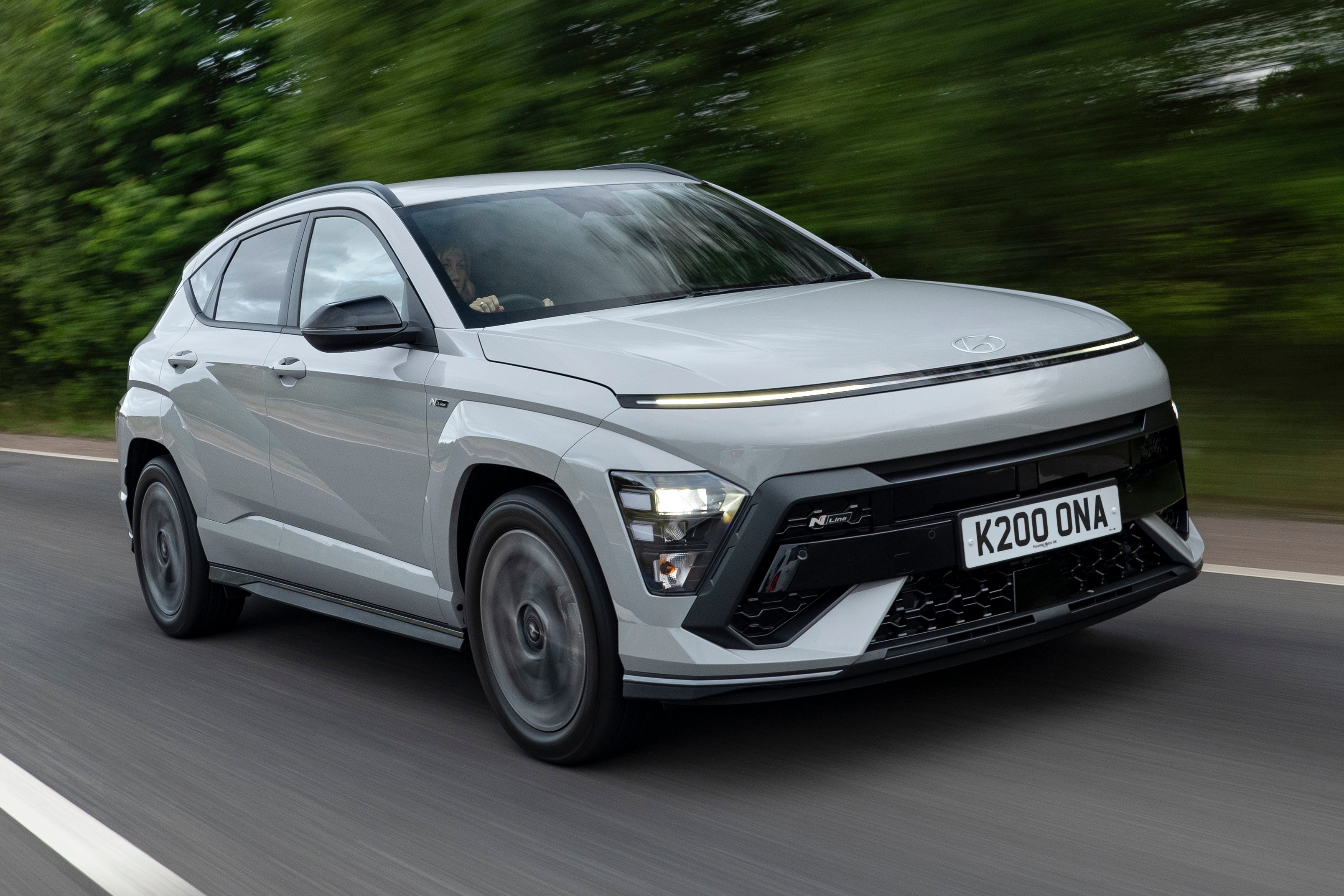Hyundai Kona Review 2025: Price, specs & boot space
Written by Ivan Aistrop
Quick overview
Pros
- Great infotainment system
- Spacious interior and good boot
- Lots of standard equipment
Cons
- Looks are divisive
- Pretty average on the road
- Some iffy cabin materials
Verdict: Is the Hyundai Kona a good car?
"The second-generation Hyundai Kona is a fantastic all-rounder that’s wrapped up in a body that looks like it’s from another planet. The out-there looks will be too much for some, as will the lacklustre driving experience, but otherwise there's a heck of a lot to like."
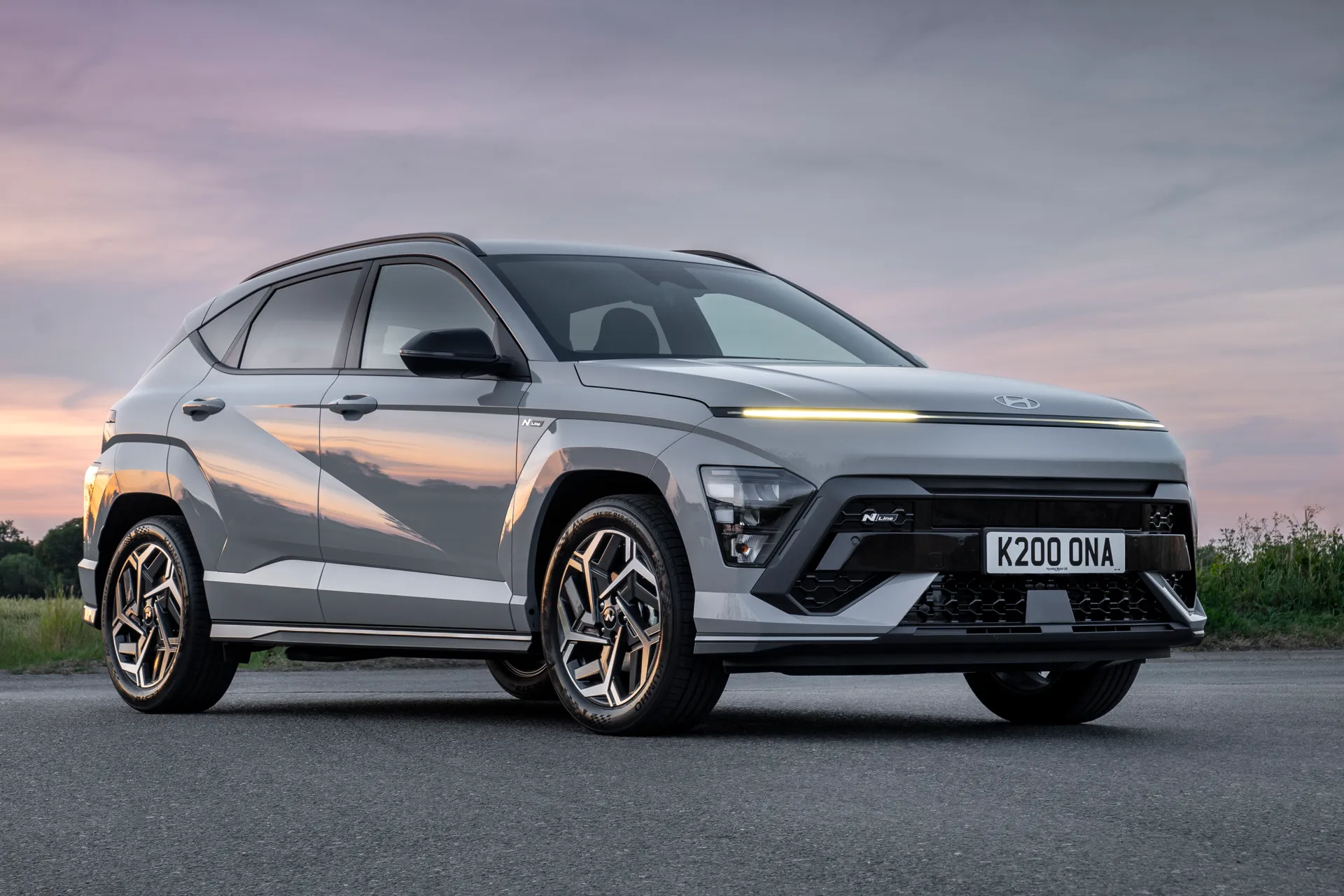
The second-generation Hyundai Kona has an incredibly tough job on its hands. Its predecessor was very successful (despite some pretty major flaws), and the second-generation car has to match that success - and build on it - in a class of car that’s saturated like no other. Find out how it goes about that in our Hyundai Kona review.
Saturated? Oh lord, yes. Small SUVs are booming and one sector that no mainstream manufacturer can afford to ignore, so all of them have at least one offering, if not two, or three... That means there are literally dozens of models to choose from, each offering something a little bit different, and with so much noise, it’s tremendously difficult for any given competitor to stand out.
Step forward the Hyundai Kona. With its unconventional styling, this car couldn't stand out more if you painted it luminous pink and fitted a perpetually blaring klaxon to the roof. The out-there looks will no doubt divide opinion, but there’s no accusing the Kona of fading into the background.
Step inside, and things aren’t quite so in-your-face, but the interior design is smart, while the twin-screen infotainment system looks great and is simple to use. True, the cabin doesn’t feel as posh as those of some rivals, but it’s sturdily built and should resist the rigours of family life very well.
Talking of family life, the latest Hyundai Kona does that better than ever before. One of the few gripes that owners of the previous version had about their car was that there wasn’t enough space in the rear seats or the boot. Happily, the new version has grown considerably, and so both of those shortcomings have been rectified, making the Kona very competitive in the practicality stakes.
Family life is also made sweeter by the generous amount of luxury equipment in all models, and importantly for a family car, provision on the safety front is impressive, too. Despite all that, prices look very reasonable compared with those of rivals, even if the Kona most certainly isn’t the budget offering you might be expecting.
We’ll make no bones about it, the Hyundai Kona is not the best car in its class to drive, far from it. The ride is a bit unsettled, the handling is lacklustre and the performance is merely so-so. In fact, by far the sweetest-driving version of the Kona is the all-electric one, known as the… err… Kona Electric, but that’s such a different proposition to the rest of the Kona range that we’ve reviewed it separately.
No, this Hyundai Kona review concentrates on the combustion-engined variants, which include a 100PS 1.0-litre turbocharged petrol, a 138PS 1.6-litre turbocharged petrol and a 129PS self-charging hybrid. It’ll come as very little surprise in this day and age to learn that no diesel is offered.
Looking for a used car for sale? We've got 100s of Hyundai Approved Used Cars for Sale for you to choose from, including a wide range of Hyundai Kona cars for sale. If you want the EV version, you need our Hyundai Kona Electric review.
Is the Hyundai Kona right for you?
It most certainly is if you’re after a small SUV that makes you stand out from the crowd. The wacky, futuristic styling of the second-generation Kona might not be to everyone’s taste, but there’s no denying that it gets you noticed. It’ll also suit you if you’re after a roomy, solidly made family car that comes with generous equipment for a competitive price, and if you fancy the peace-of-mind of a long warranty, the Kona has you covered there, too.
What’s the best Hyundai Kona model/engine to choose?
Of the combustion-engined Konas, we reckon most folk will be best off with the entry-level 1.0-litre petrol. It’s peppy and refined enough to keep life easy and civilised, and it will be the most affordable version to buy and run overall. We’d steer you clear of the 1.6-litre turbo due to its clunky power delivery, and we’d give you that steer even if choosing this engine didn’t make the Kona quite expensive. Which it does. The hybrid is good and makes sense for company drivers, but it is the most expensive version to buy.
On the trim level front, entry-level Advance trim comes with most of what you need, but N Line trim does add some desirable extras for an affordable sum, plus it looks a bit sharper. N Line S and Ultimate trims are properly tooled up, but they're expensive.
What other cars are similar to the Hyundai Kona?
As a small SUV, the Hyundai Kona has no shortage of rivals to contend with. As we’ve said, this is a booming sector of the car market that no mainstream manufacturer can afford to ignore, so all of them have at least one offering.
Volkswagen has no less than three in the form of the T-Cross, the T-Roc and the Taigo, and there are also similar offerings from elsewhere in the Volkswagen Group in the form of the Seat Arona and Skoda Kamiq. The Nissan Juke and Renault Captur are also popular alternatives, while the Citroen C3 Aircross, Vauxhall Mokka, Peugeot 2008, Honda HR-V, Ford Puma and Toyota Yaris Cross are also vying for your cash.
Comfort and design: Hyundai Kona interior
"The second-generation Kona has grown a lot compared to the car it replaced, and it’s much roomier and more practical as a result. The interior quality still leaves a little to be desired, though."
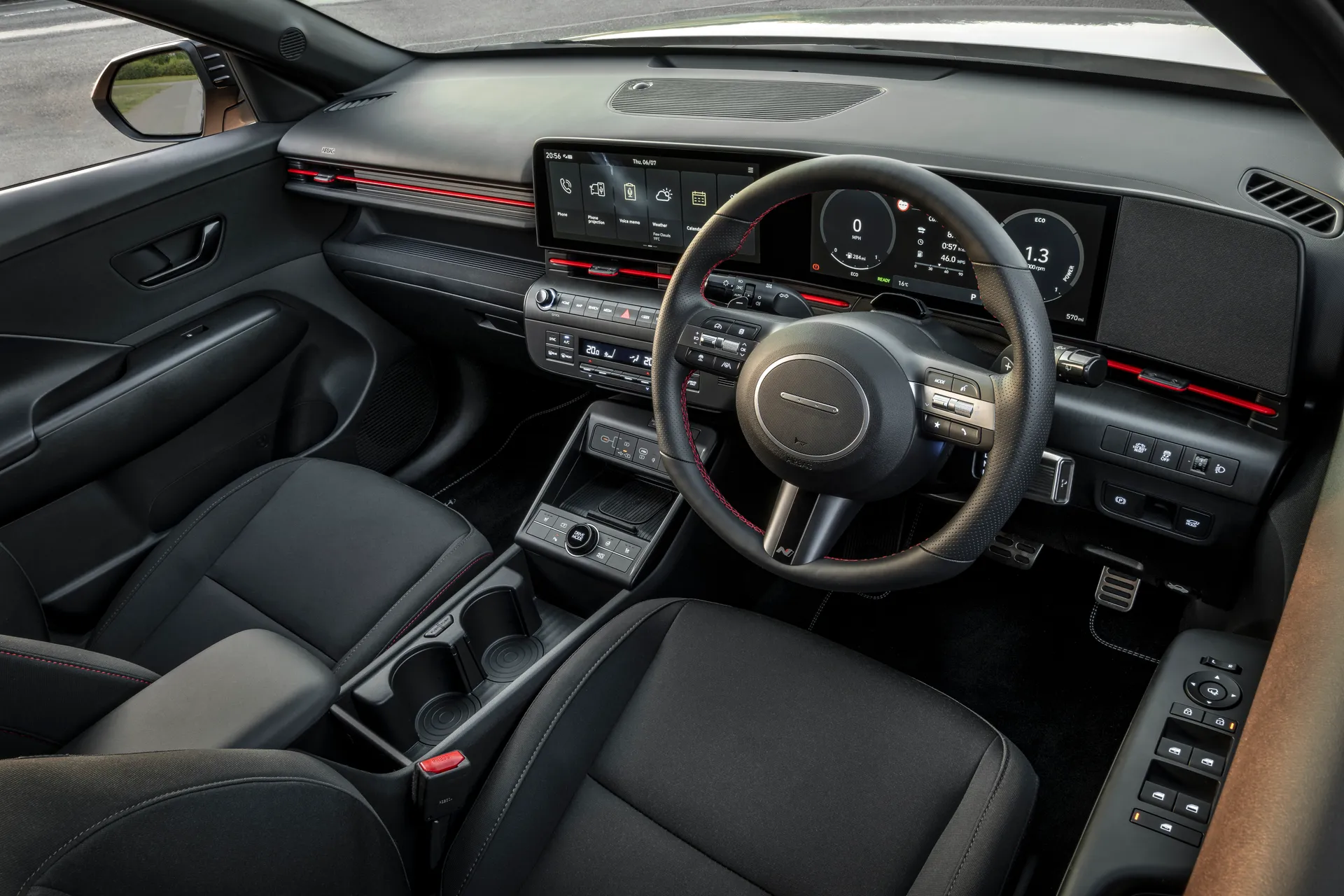
All versions of the Hyundai Kona have height adjustment on the front seats, plus four-way adjustment on the steering column, allowing drivers of all shapes and sizes to get comfy. On Hyundai Kona N Line S and Ultimate trims, the front seats move electrically to make getting comfortable even easier.
Your view at the front of the car is pretty clear, but a small rear screen with thick pillars either side means that your rear visibility isn’t quite so clear. Luckily, all Hyundai Kona trim levels come with reversing sensors and a rearview camera.
The dashboard layout is nice and simple, with large, well-marked buttons for various functions, and physical buttons and knobs for controlling the air-con, which we always prefer to touchscreen menus.
One minor annoyance is that there’s a small cluster of buttons and controls down to the right-hand side of the steering wheel, which is tucked away out of sight, and you often forget it’s there as a result: slightly problematic when you consider that this cluster houses the switch for the electronic parking brake
Quality and finish
The interior of the Hyundai Kona is a bit of a mixed bag. The design is quite futuristic, with a fairly minimalist dashboard and big digital screens, but many of the materials used are decidedly old-school. The shiny silver finish on the centre console, and the bank of sturdy grey plastic buttons beneath it, look like something from out of a 1990s Toyota: it all looks hard-wearing enough to survive a nuclear blast, but it’s not exactly a feast for the fingertips.
You’ll also find hard, unappealing plastic on the doors and - most notably - on top of the dashboard. Sure, you could also level similar criticism at many of the Kona’s rivals, but many of them still manage to feel a good bit posher.
Infotainment: Touchscreen, USB, nav and stereo in the Hyundai Kona
All versions of the Hyundai Kona get the same basic infotainment system, with higher-spec cars getting a few added bits of functionality bolted on. However, ‘basic’ is not a word you’d use to describe the system itself. It’s based around a pair of digital screens - 12.3inches for the main dash and 10.25-inches for the infotainment - built into the same curved display in similar style to the latest BMW and Mercedes efforts. The system looks great, and the touchscreen is also very simple to use, with logical menus, fast responses and impressive screen sensitivity. The digital dials look good as well, but the layout isn’t as configurable as it is with some such systems.
Functionality in all models includes navigation, Bluetooth, DAB radio, Apple CarPlay and Android Auto. You also get steering wheel controls and front and rear USB C charging points. N Line trim adds an additional wireless charging pad for your phone, while Ultimate and N Line S trims get a BOSE premium sound system with seven speakers and a subwoofer.
Space and practicality: Hyundai Kona boot space
By and large, the first-generation Hyundai Kona was incredibly well received by the people that bought it, but one of the few aspects of the car that came in for repeated criticism was its practicality. In short, rear-seat space was too tight and the boot was too small.
Happily, things have improved greatly with the latest Kona, and that’s largely because it’s been supersized. The length of the car has grown by 14 centimetres overall, with six of those centimetres sitting between the front wheels and rear wheels. If you’re interested, the Kona is 4350mm long, and 1825mm wide (not including door mirrors).
That means there’s now way more room in the rear seats - just like there is up front - with plenty of legroom and headroom even for tall adults. You don’t get the clever sliding rear seat you do in some rivals that lets you use the available space for passengers or luggage as required, but the fact that there’s now way more boot space - 466-litres regardless of which powertrain you choose - means that this is no problem.
The back seat folds down in a 40/20/40 split in all but the entry-level Advance version, which is more versatile than the 60/40 split you get in many rivals, and a moveable boot floor allows you to level off both the load lip and the step up to the folded seatbacks, although those seatbacks do lie at a slight angle. Tip the rear seats down and you free up as much as 1300-litres of load space.
Handling and ride quality: What is the Hyundai Kona like to drive?
"There are numerous areas in which the latest Kona truly excels, but its on-road behaviour isn’t one of them. Dynamically, it’s pretty average in a number of ways."
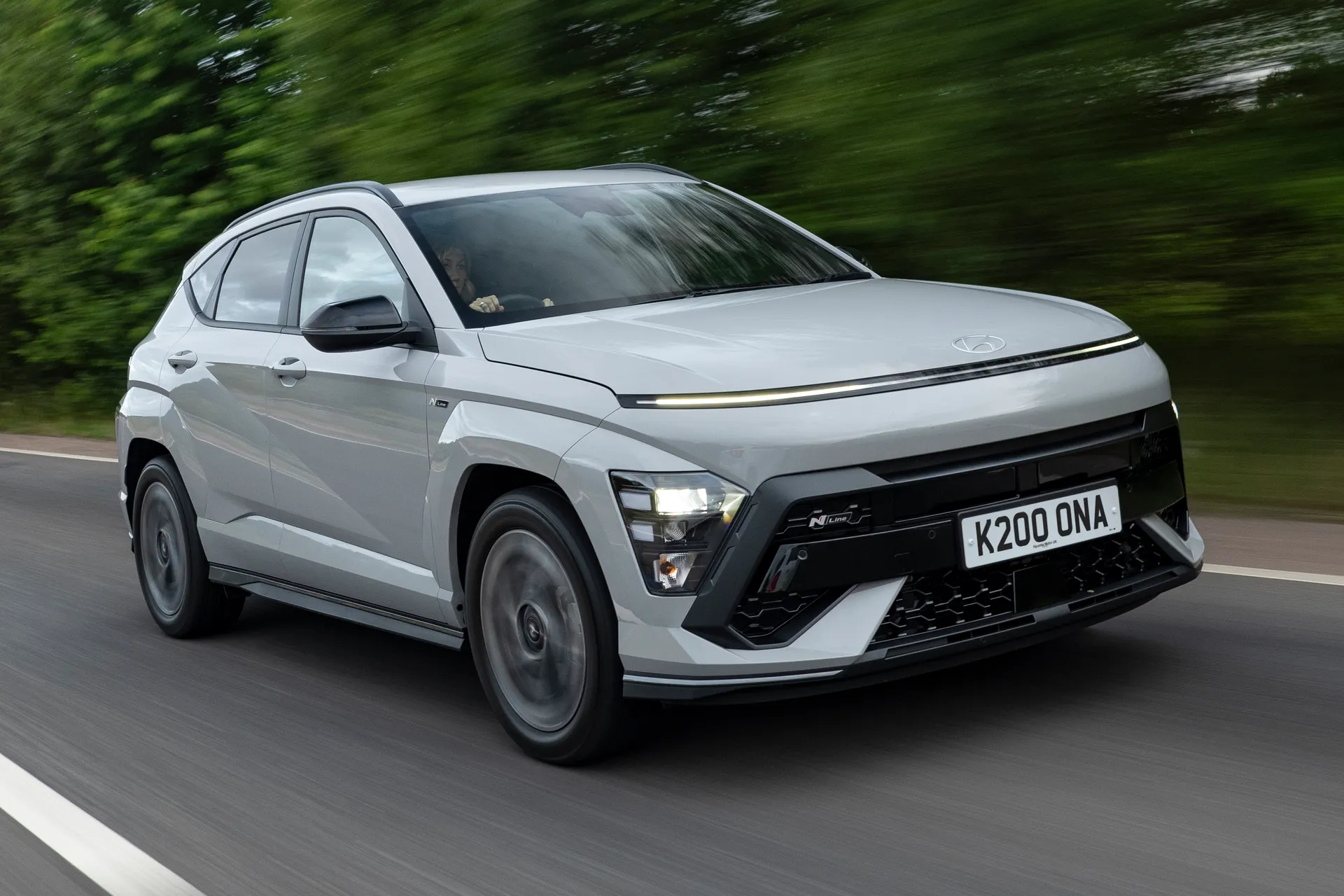
Compact SUVs are often used as family cars, and as such, a comfortable ride is probably the most important dynamic trait you can have in a car like the Hyundai Kona. However, you might be a little disappointed in that regard.
There are a few too many sorts of road surface that the car fails to deal with effectively, so it feels a little bit too jittery and unsettled for a little bit too much of the time. It stops short of being uncomfortable, but there are several rivals that are more cosseting when moving along the road.
That would be more forgivable if the car provided sharp handling in compensation, but the Kona doesn’t. There’s enough grip to make it feel stable and secure, but there’s quite a bit of body roll as you go around corners, even at moderate speed, while the lightness and vagueness of the steering doesn’t inspire a huge amount of confidence in the car’s cornering ability.
What engines and gearboxes are available in the Hyundai Kona?
We’ll ignore the Hyundai Kona Electric here as we’ve reviewed that version separately, so let’s kick this section off with the entry-level engine, the three-cylinder 1.0-litre turbo. Despite its small size, it packs a healthy 100PS, and it's mated to a six-speed manual gearbox. It’s not hugely fast but feels rather more willing and eager than you might expect, with muscular pull from low engine speeds and a willingness to rev.
You might not love the lazy throttle response: press the pedal when you’re already on the move and there’s a small delay before the power arrives, and when you lift off the pedal, there’s a similar delay before the revs fall. That aside, though, performance is absolutely fine and the engine doesn’t feel out of its depth on the motorway, either, so we think this will be the engine of choice for most drivers. Stat-fans might want to know that the one we tried does 0-62mph in 13.3 seconds.
We’d certainly recommend the 1.0-litre over the 1.6 turbo in the Hyundai Kona, the most powerful engine in the range with 138PS. It can be had with either a six-speed manual gearbox or a seven-speed dual-clutch automatic, with the 0-62mph happening in 10.2 seconds in both. We tried it with the auto, and it’s a pairing that we would frankly avoid at all costs. The gearbox works in a really clumsy way: pressing the accelerator pedal sometimes results in no forward momentum whatsoever, and it sometimes results in all of the power being delivered all at once, and you never know which you’re going to get. Not only does this make the car all-but-impossible to drive smoothly, it can also make for some pretty hairy moments when pulling out of junctions or manoeuvring. And, when you get your foot down, it doesn't ultimately feel all that fast, certainly nowhere near as fast as the power output suggests.
The priciest powertrain option is the self-charging hybrid, which uses a different 1.6-litre petrol engine and pairs it with an electric motor and a dual-clutch gearbox - this time a six-speeder - for a combined output of 129PS. At low speeds and under a gentle throttle, it’ll run around for short bursts on electric-only power (although don’t go expecting dozens of miles of electric range like you get with a plug-in hybrid), and when the petrol engine cuts back in, it does so smoothly. The 0-62mph dash takes 12.0 seconds, so it’s not exactly fast, but performance is eager enough to keep life easy.
Refinement and noise levels
The 1.0-litre engine does give off a three-cylinder thrum in the Hyundai Kona, but the noise levels are such that it manages to be characterful rather than troublesome, and you won’t feel too much in the way of vibration coming through the steering wheel and pedals.
The 1.6 petrol we tried was less refined, however: when the automatic gearbox sends the revs sky-high, which it does on a fairly regular basis, the engine sounds thrashy and coarse, while the Jekyll-and-Hyde transmission also makes for very jerky progress.
If you want the most refined drivetrain of the lot in the Hyundai Kona, go for the hybrid. It’s near-silent for the short periods that it can roll around on electric power, and it’s smooth, quiet and sedate when the petrol engine is running. In all Konas, wind- and road noise are present, but not problematic at any point.
What is problematic, though, is the ludicrous amount of bonging and beeping you’re subjected to by the car’s various driver assistance systems. There are so many that, half the time, you have no idea exactly what it is that you’re being warned about, and the assault on your eardrums is totally relentless, even if you’re driving like some sort of modern-day saint. You can switch the systems off (not something we’d usually recommend, but we’ll make an exception in this case) with some faffing around on the touchscreen, but the systems are automatically reinstated every time you switch the car on.
Safety equipment: How safe is the Hyundai Kona?
The amount of safety kit you get on your Hyundai Kona largely depends on what trims you go for. All trims - including the Advance and N Line grades - get a suite of driver assistance aids that Hyundai calls SmartSense, and this includes functions such as Downhill Brake Control, Driver Attention Warning, eCall, Forward Collision Avoidance Assist with Car, Pedestrian, Cycle and Junction Turning functions, Hill-start Assist Control, Intelligent Speed Limit Assist, Lane Keep Assist, Lane Follow Assist and Leading Vehicle Departure Alert.
Upgrade to the Ultimate or N Line S trims, and you also get Blind Spot Collision Avoidance Assist, Rear Cross Traffic Collision Avoidance Assist, Parking Distance Warning (side function), Parking Collision Avoidance Assist (reverse function), Safe Exit Warning and Surround View Monitor.
With such a comprehensive amount of gadgetry on board, it might be a little surprising that the Kona only achieved four out of five stars in Euro NCAP crash tests when it was tested in 2023. However, that might be more of a reflection of how tough the tests are to ace these days, rather than any massive deficiency with the Kona’s safety levels.
MPG and fuel costs: What does a Hyundai Kona cost to run?
"All versions of the Hyundai Kona are competitive with rivals for fuel economy, but predictably, it’s the hybrid that delivers the greatest efficiency according to official WLTP figures."
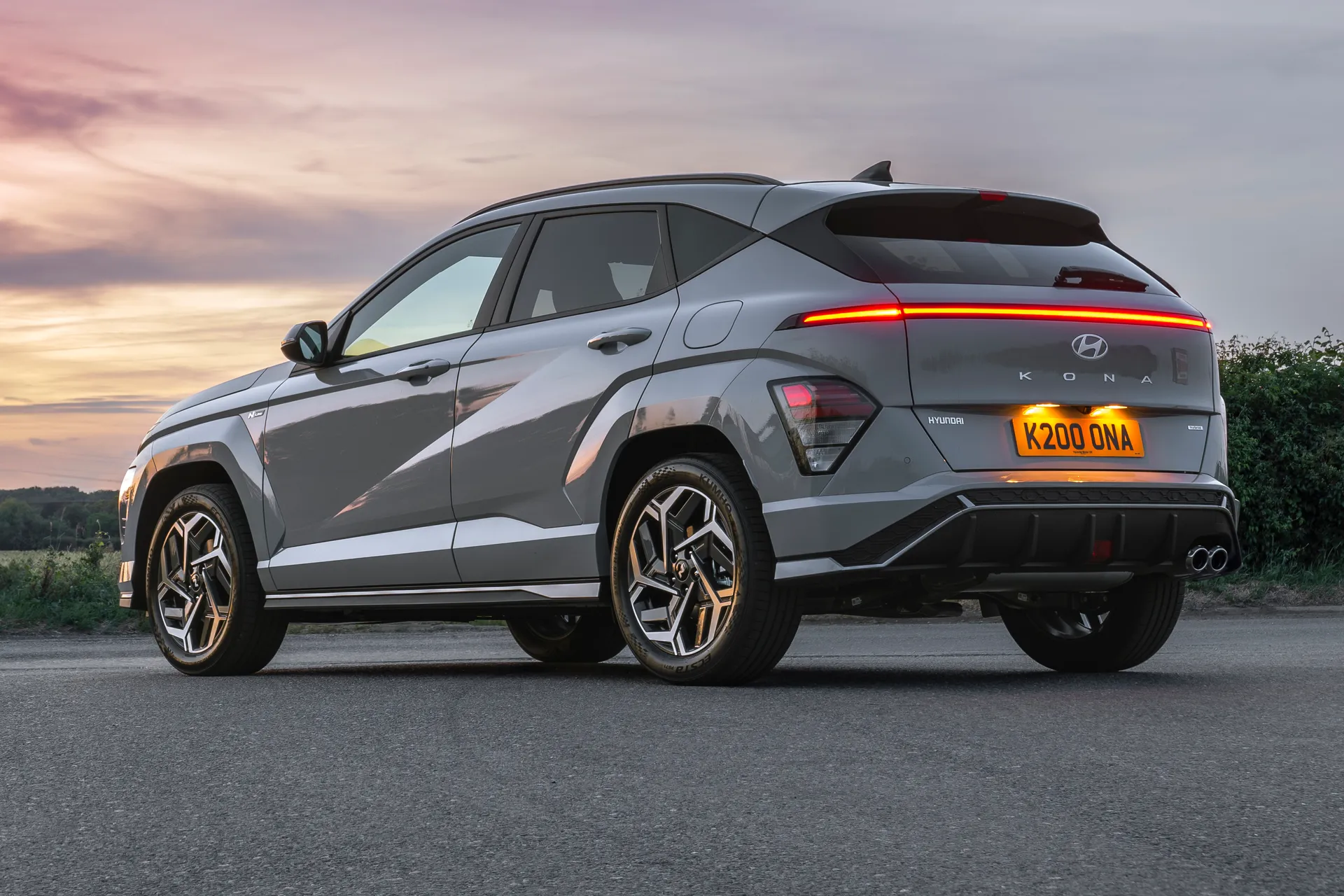
Go for the entry-level 1.0-litre turbo engine, and you’ll get an official fuel economy of around 48mpg, which isn’t bad at all compared with rivals.
Upgrade to the 1.6 turbo, and your official fuel return will drop to 45.6mpg regardless of whether you specify the manual or the auto. That makes it the thirstiest version, but the deficit isn’t all that huge when you consider how much extra power you’re getting
Predictably, the Hyundai Kona hybrid is the star of the show in this area, with an official WLTP fuel return of 60.1mpg.
Hyundai Kona reliability and warranty
Hyundai has a fabulous reputation for reliability, and that’s backed up by the data. In the most recent HonestJohn.co.uk Satisfaction Index, the brand placed 10th in the list of the top ten most reliable manufacturers with an average score of 91.53%. Hyundai also scored another 10th place for owner satisfaction, so a very good all round showing for the firm.
If that’s not enough to give you peace of mind, you’ll likely get it from the Korean firm’s tremendous five-year, unlimited-mileage warranty, which is one of the most generous arrangements in the business, and for particularly high-mileage drivers, probably the best overall.
Hyundai Kona insurance groups and costs
The most basic versions of the Hyundai Kona sit in group 14(out of 50) for insurance, meaning that they won’t exactly be cheap to insure, but they won’t be ruinous, either. That rises to group 22 if you team the same powertrain with a loftier trim level, and classifications are about the same for hybrid versions.
Go for the hybrid variant, and your insurance sits between groups 16 and 18 based on which trim you choose.
VED car tax: What is the annual road tax on a Hyundai Kona?
After the first year of registration, all Konas will cost the same £195 per year for road tax. Prior to this, the petrol-only models all come in with an initial road tax charge of £540, while the Hybrid will cost you £390 for the first year of Vehicle Excise Duty.
Cars that cost over £40,000 when brand new, including the optional extras fitted, are subject to an annual ‘luxury car’ surcharge of £425 per year on top of that for a period of five years from year two onwards. However, no Kona currently breaks that barrier no matter how much you spec it up.
Hyundai Kona price
"The Kona is by no means the budget choice it once was, but prices are at least competitive with those of rivals, and there are already some decent savings to be made on the used car market."
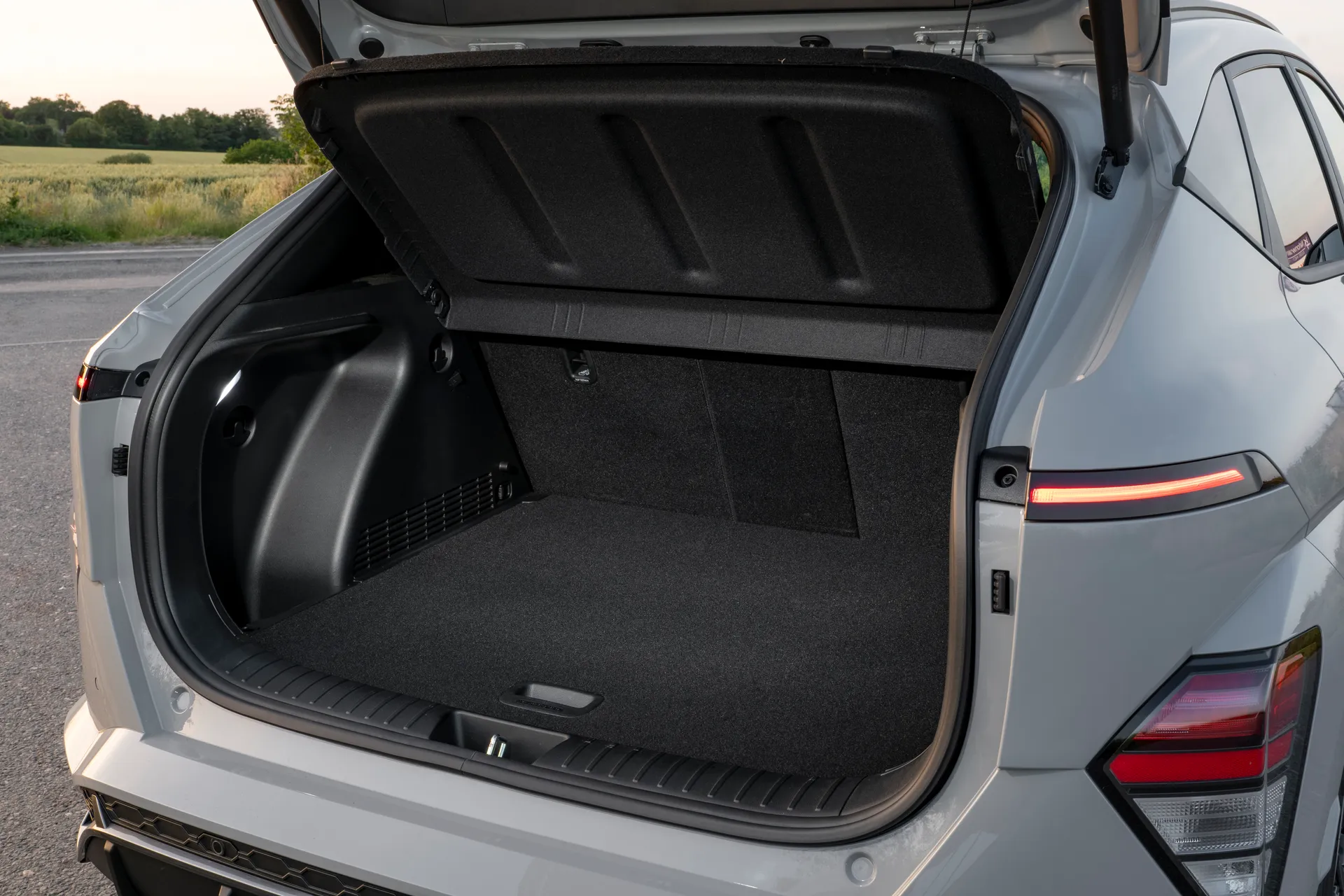
Consider a brand new Kona, and prices start from around £27,000 for the least powerful Advance model, and rise to around £35,000 for the Ultimate or N Line S in hybrid form. You certainly couldn’t really say that the Kona is still a budget option, then, but to be fair, it no longer feels like one.
Look to the used market and a year old Kona in 1.0-litre Advance trim with 10,000 miles under its wheels will cost around £20,000. A hybrid version of the same miles and age will come in from £23,000.
Trim levels and standard equipment
You can go in one of two directions with the spec of your Kona. Entry-level Advance and high-spec Ultimate trims aim to offer a certain brand of restrained luxury, while N Line and N Line S trim take a sportier approach.
As standard, the Advance comes with a generous amount of kit including 17-inch alloy wheels (18s on hybrid models), height adjustment for both front seats, dual zone climate control, automatic headlights and wipers, cruise control (smart cruise control with stop and go function on hybrid and DCT models), an electric parking brake, front- and rear parking sensors with rear camera, and keyless entry with start/stop button. That’s on top of all the infotainment and safety kit we talked about earlier.
N Line models come with extra styling goodies inside and out, such as a dedicated front- and rear bumper design, side skirts, 18-inch alloys, twin exhaust tips and black gloss door mirrors, specific cloth seat trim and aluminium pedals. The upgrade from Advance trim also earns you a small slice of extra luxury kit, including heated front and rear seats, heated steering wheel, ambient lighting and a powered tailgate.
Ultimate takes the spec of the Advance and adds a full-width horizon centre daytime running light with full projection LED headlamps, three-zone climate control, powered-, heated- and ventilated front seats upholstered in black leather (or a no-cost grey leather option) and an opening sunroof, plus the extra infotainment and safety goodies. N LIne S trim does without the sunroof, but other than that it has pretty much the same kit as the Ultimate, as well as the sportier styling.
Ask the heycar experts: common questions
Is the Hyundai Kona a good car?
Is the Hyundai Kona an SUV?
Is the Hyundai Kona reliable?
Get our latest advice, news and offers
Keep me updated by email with the latest advice, news and offers from heycar.
By submitting you agree to our privacy policy
